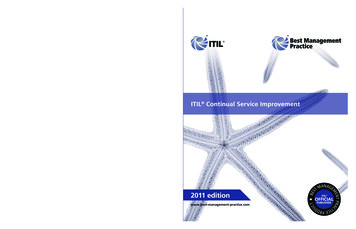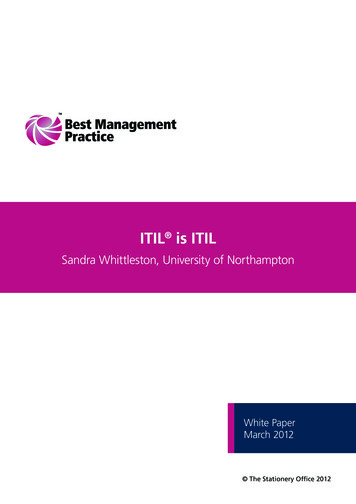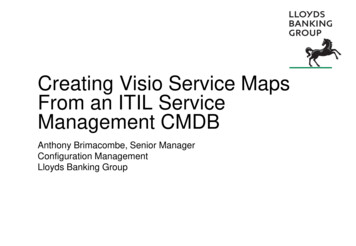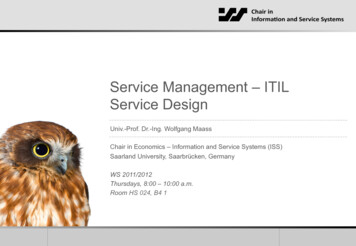
Transcription
Over time business requirements will change, so even withsuccessful service operations in place, there is still a needto re-align service provision with these changing businessneeds. What was good enough last year is unlikely to meetrequirements next year; therefore improvement opportunitiesneed to be constantly assessed and implemented. Thiscontinual cycle of service improvement will help protect againstlosing competitive edge and will ensure that the best possibleoutcomes are being achieved.ITIL Continual Service ImprovementITIL Continual Service Improvement focuses on the elementsinvolved in identifying and introducing a cycle of servicemanagement improvements. It provides structure for theapproach to assessing and measuring services, and helps youto avoid temporary fixes in favour of a continual improvementin quality that truly benefits the business customer.ITIL Continual Service Improvement2011 editionBESwww.best-management-practice.comNT PRACME9 780113 313082ANAGETMTUCISBN 978-0-11-331308-2E PRODTIC7188 ITIL CSI AN Cover V1 3.indd 1-311/07/2011 11:54
ITIL Continual Service ImprovementLondon: TSOCSI Prelims.indd 109/07/2011 09:46
Published by TSO (The Stationery Office) and available from:Onlinewww.tsoshop.co.ukMail, Telephone, Fax & E-mailTSOPO Box 29, Norwich, NR3 1GNTelephone orders/General enquiries: 0870 600 5522Fax orders: 0870 600 5533E-mail: customer.services@tso.co.ukTextphone 0870 240 3701TSO@Blackwell and other Accredited AgentsCustomers can also order publications from:TSO Ireland16 Arthur Street, Belfast BT1 4GDTel 028 9023 8451 Fax 028 9023 5401 Crown Copyright 2011This is a Crown copyright value added product, reuse of which requires a Licence from the Cabinet OfficeApplications to reuse, reproduce or republish material in this publication should be sent toThe Efficiency & Reform Group Service Desk, Cabinet Office, Rosebery Court, St Andrews Business Park,Norwich, Norfolk NR7 0HS Tel No: ( 44) (0)845 000 4999, E-mail: servicedesk@cabinet-office.gsi.gov.ukor complete the application form on the Cabinet Office website, Licensing section.Copyright in the typographical arrangement and design is vested in The Stationery Office Limited.Applications for reproduction should be made in writing to The Stationery Office Limited, St Crispins,Duke Street, Norwich, NR3 1PD.The Swirl logo is a trade mark of the Cabinet OfficeITIL is a registered trade mark of the Cabinet OfficePRINCE2 is a registered trade mark of the Cabinet OfficeM o R is a registered trade mark of the Cabinet OfficeP3O is a registered trade mark of the Cabinet OfficeMSP is a registered trade mark of the Cabinet OfficeMoV is a trade mark of the Cabinet OfficeMoP is a trade mark of the Cabinet OfficeThe OGC Official Product endorsement logo is a trade mark of the Cabinet OfficeOGC (former owner of Best Management Practice) and its functions have moved into the Cabinet Officepart of HM Government – www.cabinetoffice.gov.ukFirst edition Crown Copyright 2007Second edition Crown Copyright 2011First published 2011ISBN 9780113313082Printed in the United Kingdom for The Stationery OfficeMaterial is FSC certified and produced using ECF pulp.Sourced from fully sustainable forests.P002425506CSI Prelims.indd 2c70 07/1109/07/2011 09:46
ContentsList of figuresvList of troduction11.1 Overview31.2 Context623CSI Prelims.indd 31.3 ITIL in relation to other publicationsin the Best Management Practiceportfolio81.4 Why is ITIL so successful?81.5 Chapter summary10Service management as a practice112.1 Services and service management132.2 Basic concepts202.3 Governance and managementsystems252.4 The service lifecycle274563.11 Frameworks, models, standardsand quality systems423.12 CSI inputs and outputs44Continual service improvementprocesses454.1 The seven-step improvementprocess47Continual service improvementmethods and techniques715.1 Methods and techniques735.2 Assessments745.3 Benchmarking795.4 Service measurement855.5 Metrics915.6 Return on investment1065.7 Service reporting1115.8 CSI and other servicemanagement processes1125.9 Summary125Organizing for continual serviceimprovement1276.1 Organizational development1296.2 Functions1296.3 Roles1296.4 Customer engagement1386.5 Responsibility model – RACI1386.6 Competence and training139Technology considerations143Continual service improvementprinciples333.1 Continual service improvementapproach353.2 CSI and organizational change363.3 Ownership363.4 CSI register363.5 External and internal drivers373.6 Service level management377.1 Tools to support CSI activities1453.7 Knowledge management387.2 Summary1523.8 The Deming Cycle383.9 Service measurement383.10 IT governance42709/07/2011 09:46
iv Contents89Implementing continual serviceimprovement1538.1 Critical considerations forimplementing CSI1558.2 Where do I start?1558.3 Governance1568.4 CSI and organizational change1578.5 Communication strategy and plan1628.6 Summary164Challenges, risks and criticalsuccess factors1659.1 Challenges1679.2 Critical success factors1679.3 Risks1679.4 Summary168Afterword169Appendix A: Related guidance173A.1ITIL guidance and web services175A.2Quality management system175A.3Risk management176A.4Governance of IT176A.5COBIT176A.6ISO/IEC 20000 servicemanagement series177Environmental managementand green/sustainable IT177ISO standards and publicationsfor IT178ITIL and the OSI framework178A.7A.8A.9CSI Prelims.indd 4A.10 Programme and projectmanagement179A.11 Organizational change179A.12 Skills Framework for theInformation Age180A.13 Carnegie Mellon: CMMI and eSCMframework180A.14 Balanced scorecard180A.15 Six Sigma180Appendix B: Example of a continualservice improvement register183Appendix C: Risk assessment andmanagement187C.1 Definition of risk and riskmanagement189C.2 Management of Risk (M o R)189C.3 ISO 31000190C.4 ISO/IEC 27001191C.5 Risk IT192Appendix D: Examples of inputs andoutputs across the service lifecycle195Abbreviations and glossary199Index23909/07/2011 09:46
List of figuresFigure 1.1The ITIL service lifecycleFigure 1.2ITIL’s relationship with other BestManagement Practice guides9Conversation about the definitionand meaning of services14Logic of value creation throughservices18Sources of service managementpractice19Examples of capabilities andresources21Figure 2.5Process model21Figure 2.6The service portfolio and itscontents25Figure 2.7Architectural layers of an SKMS26Figure 2.8Plan-Do-Check-Act cycle27Figure 2.9Integration across the servicelifecycle30Figure 2.1Figure 2.2Figure 2.3Figure 2.4Figure 2.10 Continual service improvementand the service lifecycleFigure 3.133135Knowledge management leads tobetter IT decisions38Figure 3.3Why do we measure?39Figure 3.4The seven-step improvementprocess40Knowledge spiral – a gatheringactivity41Enterprise governance(source: CIMA)Figure 4.1Figure 4.2Figure 3.5Figure 3.6Figure 4.3Figure 4.4CSI Prelims.indd 5First- to fourth-order drivers64Figure 5.1The relationship of services,processes and systems77The value of a process versus thematurity of a process79Figure 5.3Availability reporting86Figure 5.4Service measurement model88Figure 5.5Technology domain versusservice management89Figure 5.6Service management model90Figure 5.7From vision to measurement92Figure 5.8Number of incidents opened byservice desk over time96Comparison of incidents openedand resolved on first contact bythe service desk96Figure 5.2Continual service improvementapproachFigure 3.2Figure 4.5Figure 5.9Figure 5.10 Deriving measurements andmetrics from goals andobjectivesFigure 5.11Reported outage minutes fora service99100Figure 5.12 IT balanced scorecard104Figure 5.13 The expanded incident lifecycle114Figure 5.14 Connecting business and servicecapacity management116Figure 5.15 Business capacity growth model117Figure 5.16 Connecting service and componentcapacity management11742Figure 5.17 Connecting businesses, serviceand component capacitymanagement117From vision to measurements50Figure 5.18 Capacity management activities120Monitoring and data collectionproceduresFigure 5.19 Sources of knowledge12355Figure 5.20 Reasons for a risk managementprocess124Common procedures forprocessing the data57Service level achievement chart62Figure 6.1Activities and skill levels neededfor continual serviceimprovement13409/07/2011 09:46
vi List of figuresFigure 6.2Service management roles andcustomer engagement139The application of thearchitectural layers of the CMS147Service-centric view of the ITenterprise151Process re-engineering changeseverything157Figure 8.2Vision becomes blurred163Figure 8.3CSI roles and inputs164Figure C.1The M o R framework190Figure C.2ISO 31000 risk managementprocess flow191ISACA Risk IT processframework193Figure 7.1Figure 7.2Figure 8.1Figure C.3CSI Prelims.indd 609/07/2011 09:46
viiList of tablesTable 2.1The processes described in eachcore ITIL publication29CSI inputs and outputs bylifecycle stage43Table 4.1Policy template example49Table 4.2Monitoring and data collectionproceduresTable 3.1Table 4.3Table 5.1Table 5.2Procedures for processing thedataPros and cons of assessmentapproachesTable 6.1Table 6.2555776Average results of over 100process assessments beforeimprovement84Table 5.3CMMI maturity model84Table 5.4Key performance indicators ofthe value of service managementprocesses90Table 5.5Table 5.6Table 5.7Table 5.8Table 5.9High-level goals and keyperformance indicatorsTable 6.5Table 6.6Table 6.8Table 6.991Table 8.1Examples of service qualitymetrics94Response times for three servicedesks97An example of a summary reportformat100Service report of outage minutescompared to goal101Percentage of incidents meetingtarget time for service restoration 101Table 5.11Sample key performanceindicators102Service desk balanced scorecardexample105Table 5.13SWOT analysis107Table 5.14Sample SWOT analysis for CSI107Table 5.15Departmental requirements116Table 5.16Risk register125CSI Prelims.indd 7Table 6.4Table 6.7Table 5.10Table 5.12Table 6.3Table 8.2Skills involved in Step 1 – Identifythe strategy for improvement135Skills involved in Step 2 – Definewhat you will measure135Skills involved in Step 3 – Gatherthe data135Skills involved in Step 4 – Processthe data135Skills involved in Step 5 – Analysethe information and data136Skills involved in Step 6 – Presentand use the information136Skills involved in Step 7 –Implement improvement136Comparison of CSI manager,service level manager, serviceowner and business relationshipmanager roles137An example of a simple RACImatrix140Eight steps that need to beimplemented, and the mainreasons why transformationefforts fail (from Kotter, 1996)158Table for sample communicationplan16309/07/2011 09:46
ForewordBack in the 1980s no one truly understood ITservice management (ITSM), although it wasclear that it was a concept that needed to beexplored. Hence a UK government initiative wasinstigated and ITIL was born. Over the years,ITIL has evolved and, arguably, is now the mostwidely adopted approach in ITSM. It is globallyrecognized as the best-practice framework. ITIL’suniversal appeal is that it continues to provide aset of processes and procedures that are efficient,reliable and adaptable to organizations of allsizes, enabling them to improve their own serviceprovision.Having progressed a service from strategy todesign through transition and then into liveoperation, where do we go then? Continual serviceimprovement (CSI) is the answer.One of the cornerstones of the ITIL service lifecycleis that we should always strive to improve, as todo otherwise leads to standing still, potentiallyfollowed by stagnation and ultimately death.Improvements can be a reduction in weaknesses oran enhancement of strengths, as well as adoptingnew approaches to existing activities. ITIL ContinualService Improvement offers guidance on ways tomeasure, review and act to identify and adoptimprovements in service provision. If you have notstarted your IT service management journey thenyou may find that this publication is a good placeto start, as you can use it to identify those areaswhere your organization will most benefit fromapplying service management practices.There is an associated qualification scheme so thatindividuals can demonstrate their understandingand application of the ITIL practices. So whetheryou are starting out or continuing along the ITILpath, you are joining a legion of individuals andorganizations who have recognized the benefits ofgood quality service and have a genuine resolve toimprove their service level provision.ITIL is not a panacea to all problems. It is, however,a tried and tested approach that has been provento work.I wish you every success in your servicemanagement journey.Frances ScarffHead of Best Management PracticeCabinet OfficeThe principles contained within ITIL ContinualService Improvement have been proven countlesstimes in the real world. We encourage feedbackfrom business and the ITSM community, as wellas other experts in the field, to ensure that ITILremains relevant. This practice of continual serviceimprovement is one of the cornerstones of the ITILframework and the fruits of this labour are herebefore you in this updated edition.CSI Prelims.indd 809/07/2011 09:46
Preface‘Learning is not compulsory neither is survival.’W Edwards DemingContact informationThis is the fifth book in the series of five ITIL corepublications containing advice and guidancearound the activities and processes associated withthe five stages of the service lifecycle. The primarypurpose of the continual service improvementstage of the service lifecycle is to learn fromexperience and to apply that learning in order tocontinually improve the quality of IT services andto optimize anagement-ITIL/Continual service improvement must permeateand become woven into every stage of theservice lifecycle and into every process, function,activity, tool, supplier and member of staff. Thiswill invo
ITIL Continual Service Improvement www.best-management-practice.com I T IL C o n t i n u a l Se r v i c e I m pr o v e me n t 9 780113313082 ISBN 978-0-11-331308-2 Over time business requirements will change, so even with successful service operations in place, there is still a need to re-align service provision with these changing business needs. What was good enough last year is .











